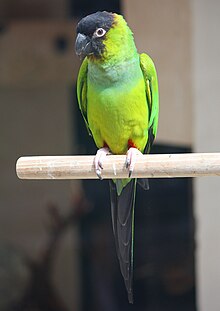Nanday parakeet
| Nanday parakeet | |
|---|---|
 |
|
| In Strasbourg, Parc de l'Orangerie | |
| Scientific classification | |
| Kingdom: | Animalia |
| Phylum: | Chordata |
| Class: | Aves |
| Order: | Psittaciformes |
| Family: | Psittacidae |
| Tribe: | Arini |
| Genus: | Aratinga |
| Species: | A. nenday |
| Binomial name | |
|
Aratinga nenday (Vieillot, 1823) |
|
| Synonyms | |
|
Nandayus nenday |
|
Nandayus nenday
The nanday parakeet (Aratinga nenday) also known as the black-hooded parakeet or nanday conure is a medium-small mostly green Neotropical parrot. The bird is native to South America from southeast Bolivia to southwest Brazil, central Paraguay and northern Argentina, from the region known as the Pantanal. Caged birds have been released in some areas and the birds have established self-sustaining populations in Los Angeles, California, San Antonio, Texas, and several areas of Florida (including Pasco County, Pinellas County, Manatee County, Broward County, and Miami-Dade County). Another self-sustaining population has existed for several decades in Israel, near the city of Pardes Hanna-Karkur.
The nanday parakeet was a member of the monotypic genus Nandayus Bonaparte, 1854 one of the approximately 16 genera of Neotropical parrots of tribe Arini which includes the conures and macaws. However, phylogenetic evidence showed that it is positioned in one of the four groups in the genus Aratinga. When the genus Aratinga was revised and split in four separate genera, this species was included in the current genus Aratinga. This revision was based on earlier studies. According to a mtDNA-based phylogenetic analysis of the genus Aratinga by Ribas & Miyaki (2004), the nanday conure forms a monophyletic group with the sun conure (A. solstitialis), jenday conure (A. jandaya), and golden-capped conure (A. auricapilla). Tavares et al. (2005) in a mitochondrial and nuclear DNA analysis of 29 species representing 25 of 30 genera of Neotropical parrots found the nanday conure's closest relative to be Aratinga solstitialis, the sun conure, and the time of divergence of the species to have been 0.5 to 1.3 mya.
...
Wikipedia

